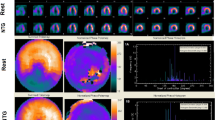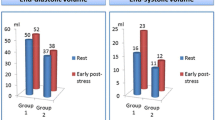Abstract
Q waves may be observed in the absence of non-viable tissue. However, their scintigraphic translation in patients with ischemic cardiomyopathy (ICM) has not been properly assessed. This study sought to establish the determinants of Q waves in the absence of non-viable tissue and the diagnostic accuracy in this population. A retrospective study enrolling 487 consecutive patients (67.0 [57.4 – 75.4] years), with ICM, LVEF < 40% and narrow QRS who underwent stress-rest 99 m-Tc SPECT was conducted. A 17-segment model for myocardium was used: Myocardium was divided in basal (1 to 6), mid (7 to 12), apical (13 to 16) and apex (17) segments. Non-viable tissue was defined as a severe perfusion defect without systolic thickening. Patients with Q waves (65.7%) had more non-viable tissue, more extensive scar and less ischemia. Q waves had a moderate correlation with non-viable tissue (AUC = 0.63) and were associated with the extension of the scar. After excluding patients with non-viable tissue in any myocardial segment, Q waves were observed in 51.9% of the patients, of which 78.1% had a scar fulfilling viability criteria. The presence of Q waves was associated with the location of these scars in a base-to-apex axis (OR = 1.88 [1.35–2.62] for segment towards the apex) and their extent (OR = 1.19 [1.05 – 1.35] for each segment). In patients with ICM, Q waves discriminate poorly viable from non-viable tissue. Q waves in this population may be due to extensive scars fulfilling viability criteria located in apical segments.



Similar content being viewed by others
Data availability
The data would be available upon proper request.
References
Felker GM, Shaw LK, O’Connor CM (2002) A standardized definition of ischemic cardiomyopathy for use in clinical research. J Am Coll Cardiol 39(2):210–218
Krone RJ, Friedman E, Thanavaro S, Miller JP, Kleiger RE, Oliver GC (1983) Long-term prognosis after first Q-wave (transmural) or non-Q-wave (nontransmural) myocardial infarction: analysis of 593 patients. Am J Cardiol 52(3):234–239
Armstrong PW, Fu Y, Chang WC, Topol EJ, Granger CB, Betriu A et al (1998) Acute coronary syndromes in the GUSTO-IIb trial: prognostic insights and impact of recurrent ischemia. The GUSTO-IIb investigators. Circulation 98(18):1860–1868
Sullivan W, Vlodaver Z, Tuna N, Long L, Edwards JE (1978) Correlation of electrocardiographic and pathologic findings in healed myocardial infarction. Am J Cardiol 42(5):724–732
Freifeld AG, Schuster EH, Bulkley BH (1983) Nontransmural versus transmural myocardial infarction. A morphologic study. Am J Med 75(3):423–432
Antalóczy Z, Barcsák J, Magyar E (1988) Correlation of electrocardiologic and pathologic findings in 100 cases of Q wave and non-Q wave myocardial infarction. J Electrocardiol 21(4):331–335
Schinkel AF, Bax JJ, Boersma E, Elhendy A, Vourvouri EC, Roelandt JRTC et al (2002) Assessment of residual myocardial viability in regions with chronic electrocardiographic Q-wave infarction. Am Heart J 144(5):865–869
Schinkel AFL, Bax JJ, Elhendy A, Boersma E, Vourvouri EC, Sozzi FB et al (2002) Assessment of viable tissue in Q-wave regions by metabolic imaging using single-photon emission computed tomography in ischemic cardiomyopathy. Am J Cardiol 89(10):1171–1175
Candell-Riera J, Rodríguez J, Puente A, Pereztol-Valdés O, Castell-Conesa J, Aguadé-Bruix S (2005) Myocardial perfusion (SPECT) in patients with non-Q-wave myocardial infarction. Med Clin 125(15):574–577
Wu E, Judd RM, Vargas JD, Klocke FJ, Bonow RO, Kim RJ (2001) Visualisation of presence, location, and transmural extent of healed Q-wave and non-Q-wave myocardial infarction. Lancet 357(9249):21–28
Sievers B, John B, Brandts B, Franken U, van Bracht M, Trappe H-J (2004) How reliable is electrocardiography in differentiating transmural from non-transmural myocardial infarction? A study with contrast magnetic resonance imaging as gold standard. Int J Cardiol 97(3):417–423
Moon JCC, De Arenaza DP, Elkington AG, Taneja AK, John AS, Wang D et al (2004) The pathologic basis of Q-wave and non-Q-wave myocardial infarction: a cardiovascular magnetic resonance study. J Am Coll Cardiol 44(3):554–560
Kaandorp TAM, Bax JJ, Lamb HJ, Viergever EP, Boersma E, Poldermans D et al (2005) Which parameters on magnetic resonance imaging determine Q waves on the electrocardiogram? Am J Cardiol 95(8):925–929
Nadour W, Doyle M, Williams RB, Rayarao G, Grant SB, Thompson DV et al (2014) Does the presence of Q waves on the EKG accurately predict prior myocardial infarction when compared to cardiac magnetic resonance using late gadolinium enhancement? A cross-population study of noninfarct vs infarct patients. Hear Rhythm 11(11):2018–2026
Engblom H, Carlsson MB, Hedström E, Heiberg E, Ugander M, Wagner GS et al (2007) The endocardial extent of reperfused first-time myocardial infarction is more predictive of pathologic Q waves than is infarct transmurality: a magnetic resonance imaging study. Clin Physiol Funct Imaging 27(2):101–108
Kristensen SL, Castagno D, Shen L, Jhund PS, Docherty KF, Rørth R et al (2020) Prevalence and incidence of intra-ventricular conduction delays and outcomes in patients with heart failure and reduced ejection fraction: insights from PARADIGM-HF and ATMOSPHERE. Eur J Heart Fail. https://doi.org/10.1002/ejhf.1972
Cerqueira MD, Weissman NJ, Dilsizian V, Jacobs AK, Kaul S, Laskey WK et al (2002) Standardized myocardial segmentation and nomenclature for tomographic imaging of the heart. A statement for healthcare professionals from the cardiac imaging committee of the council on clinical cardiology of the American heart association. Circulation 105(4):539–542
Rovai D, Di Bella G, Rossi G, Lombardi M, Aquaro GD, L’Abbate A et al (2007) Q-wave prediction of myocardial infarct location, size and transmural extent at magnetic resonance imaging. Coron Artery Dis 18(5):381–389
Durrer D, van Dam RT, Freud GE, Janse MJ, Meijler FL, Arzbaecher RC (1970) Total excitation of the isolated human heart. Circulation 41(6):899–912
Das MK, Khan B, Jacob S, Kumar A, Mahenthiran J (2006) Significance of a fragmented QRS complex versus a Q wave in patients with coronary artery disease. Circulation 113(21):2495–2501
Allencherril J, Fakhri Y, Engblom H, Heiberg E, Carlsson M, Dubois-Rande J-L et al (2018) Correlation of anteroseptal ST elevation with myocardial infarction territories through cardiovascular magnetic resonance imaging. J Electrocardiol 51(4):563–568
Farrell RM, Syed A, Syed A, Gutterman DD (2008) Effects of limb electrode placement on the 12- and 16-lead electrocardiogram. J Electrocardiol 41(6):536–545
Pahlm O, Wagner GS (2008) Proximal placement of limb electrodes: a potential solution for acquiring standard electrocardiogram waveforms from monitoring electrode positions. J Electrocardiol 41(6):454–457
Ananthasubramaniam K, Chow BJW, Ruddy TD, deKemp R, Davies RA, DaSilva J et al (2005) Does electrocardiographic Q wave burden predict the extent of scarring or hibernating myocardium as quantified by positron emission tomography? Can J Cardiol 21(1):51–56
Funding
No funding was provided to conduct this study.
Author information
Authors and Affiliations
Corresponding author
Ethics declarations
Conflict of interest
E. Ródenas has received non-conditioned grants from Biotronik, Micropport, Johnson and Johnson, Sanofi and Sanofi Genzyme. No other conflicts of interests are declared.
Ethical approval
The study protocol was approved by the local ethics committee of Vall d’Hebron University Hospital (registered as PR(AG)377/2020).
Additional information
Publisher's Note
Springer Nature remains neutral with regard to jurisdictional claims in published maps and institutional affiliations.
Rights and permissions
About this article
Cite this article
Ródenas-Alesina, E., Jordán, P., Herrador, L. et al. Q waves in ischemic cardiomyopathy. Int J Cardiovasc Imaging 37, 2085–2092 (2021). https://doi.org/10.1007/s10554-021-02172-9
Received:
Accepted:
Published:
Issue Date:
DOI: https://doi.org/10.1007/s10554-021-02172-9




